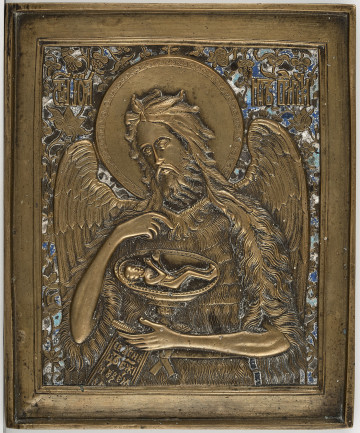
St. John the Baptist
20th century
Castle Museum in Łańcut
Part of the collection: Icons
The birth of the Mother of God foretold in the books of the Old Testament was not recorded by the books of the New Testament. Details of the life of the Mother of God appeared in non-canonical apocryphal works. The oldest of these is the 2nd century Protoevangelium of James describing the birth and childhood of Mary and the birth of Jesus until the Holy Family fled to Egypt. Mary’s parents came from a priestly and royal family but were considered infertile. Listening to their prayers, God sent an angel to announce the coming of a child. When Joachim and Anna met by the Golden Gate, they shared the joyful news and within a year lived to see the birth of their daughter, who was Maria. The oldest images depicting the birth of the Mother of God date back to the 6th century. Their composition has been expanded over time to include more characters and details. In the icon of the Nativity of the Mother of God, Saint Anne, lying or seated on a bed, is served by several handmaids, one of whom holds Mary shrouded in wrappings. Usually, in the lower part of the painting, the bath of the new-born is depicted or the vessels prepared for the bath are shown, as in the icon in question. The figure of Joachim in the background appears only on icons of the Nativity of Mary from the 14th century onwards. The Feast of the Nativity of the Mother of God is one of the twelve most important feasts of the liturgical year in the Orthodox churches; it was introduced in Byzantium in the 6th century under emperor Maurice and is celebrated in Orthodox churches on September 21 (September 8 according to the Julian calendar). Since the development of multi-zone altar partitions in Russia, the icon depicting the feast is placed in the festive row of the iconostasis. In the Catholic Church, the feast of the Nativity of the Mother of God was established in the 13th century. Teresa Bagińska-Żurawska https://orcid.org/0000-0002-9243-3967
Dimensions
height: 53 cm, width: 43.5 cm
Object type
Icons
Technique
gilding, tempera
Material
silver, tempera, wood
Origin / acquisition method
decyzja administracyjna
Creation time / dating
Creation / finding place
Owner
Castle Museum in Łańcut
Identification number
Location / status

20th century
Castle Museum in Łańcut

19th (?) century
Castle Museum in Łańcut

1800 — 1850
Castle Museum in Łańcut
DISCOVER this TOPIC
Museum of King Jan III's Palace at Wilanów
DISCOVER this PATH
Educational path